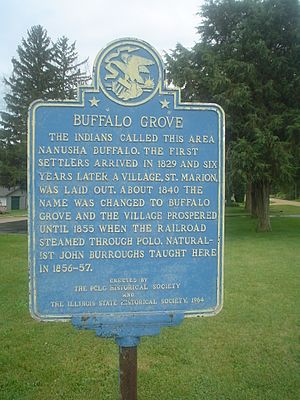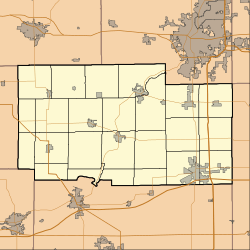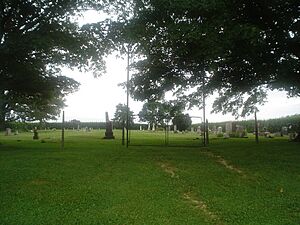Buffalo Grove, Ogle County, Illinois facts for kids
Quick facts for kids
Buffalo Grove
Nanusha
St. Marion, Buffalo
|
|
|---|---|

Sign along Milledgeville Road
|
|
| Country | United States |
| State | Illinois |
| County | Ogle |
| Township | Buffalo |
| Founded | 1830 |
| Elevation | 846 ft (258 m) |
| Time zone | UTC-6 (CST) |
| • Summer (DST) | UTC-5 (CDT) |
| ZIP code |
61064 (Polo)
|
| Area code(s) | 779, 815 |
Buffalo Grove is a small, unincorporated community in Ogle County, Illinois. It was the very first settlement in Ogle County. Long ago, it was a busy frontier town where many early settlers lived. But when the Illinois Central Railroad was built, most people and businesses moved to a new town called Polo. Today, Buffalo Grove is a quiet place with only a few dozen homes.
Contents
History of Buffalo Grove
Early Settlers and Land Claims
In the early 1800s, many people from the eastern United States traveled to Galena. They went there because lead mines had been opened. Many trails from Dixon's Ferry (an old crossing point) passed through what is now Ogle County.
In 1829, a man named John Ankeny marked a trail from Dixon's Ferry to Galena. He claimed a wooded area for himself. In the spring of 1830, Isaac Chambers built the first cabin in Ogle County near the Galena Trail. Chambers wanted to open an inn or tavern. It would be a place for travelers to stop on their way to Galena.
When Ankeny returned, he and Chambers argued over who owned the land. Chambers won the dispute. Ankeny then moved further down the trail and opened his own tavern.
By the spring of 1831, Oliver W. Kellogg arrived in Buffalo Grove. He bought his land claim from Chambers. Another settler, Samuel Reed, planted 14 acres (57,000 m2) of corn in 1831. By 1832, he also grew wheat. This was the first farm in Ogle County.
The Black Hawk War and Its Impact
Later that spring, the Black Hawk War began. The first fight was at Stillman's Run. The Sauk tribe won this battle against Colonel Isaiah Stillman's militia. Messages were sent to all settlers, telling them to go to the military headquarters near Dixon's Ferry.
The settlers from Buffalo Grove first went to Dixon's Ferry. Then they moved to Peoria, where they stayed until September. While the settlers were away, some men returned to Buffalo Grove. They wanted to check on their animals. When they got back, they found William Durley's body in the road. This sad event became known as the Buffalo Grove ambush.
Durley was first buried near where he died. The people who buried him later became victims of the St. Vrain massacre the next day. In 1910, the Polo Historical Society moved Durley's remains. They also put up a historical marker and memorial over his new grave.
Growth and Change in the Settlement
The settlement continued to grow after the war. The Buffalo Grove Post Office was opened on February 12, 1833. Some records say it might have been 1835. The first merchant, Colonel John D. Stevenson, arrived in 1834. He came from Louisiana to open a store.
The next year, the town was planned out and named St. Marion. But the post office was called Buffalo Grove. The residents officially changed the settlement's name to Buffalo Grove in 1839. In 1836, the first sawmill in the area was built. It was located along Buffalo Creek. You can still see some traces of it today.
The Railroad's Arrival and Decline
When the Illinois Central Railroad (ICRR) started building tracks in 1852, Buffalo Grove had almost 1,000 residents. In 1835, about 15 families lived near Buffalo Grove. Also in 1852, a steam-powered sawmill was built. It made railroad ties for the ICRR.
After the Illinois Central Railroad was built, a new town called Polo was founded in March 1853. It was built right along the new train tracks. Almost all the people and businesses from Buffalo Grove moved to Polo. They wanted to be closer to the new railroad.
The Buffalo Grove Post Office was even moved in the middle of the night in January 1855! It reopened in its new Polo location the next morning. A famous person who lived in Buffalo Grove was naturalist John Burroughs. He taught there from 1856 to 1857 before moving back East. Today, Buffalo Grove is no longer a true village. It is just a small area with about a dozen homes.
What's in a Name?
Native Americans who lived in the Buffalo Grove area called it "Nanusha." This word meant "buffalo." When white settlers arrived, they did not find any live buffalo. Instead, they found many buffalo bones.
In the winter of 1778, there was a very heavy snowfall in the Mississippi Valley. The temperatures changed, causing the snow to melt and then refreeze. This created a hard crust over the snow. Because of this, the buffalo could not reach their food, and many starved to death.
Church and Cemetery
Buffalo Grove has one cemetery called Reed Cemetery. It is located west of the community. The cemetery got its name from Samuel Reed, Sr. He died suddenly on August 17, 1833. Reed was the first person buried in the new cemetery, so it was named after him.
In the fall of 1843, Elder Alexander Conlee started the Buffalo Grove Church. At first, the church group met at the Doty School. This building was used as both a school and a church.




